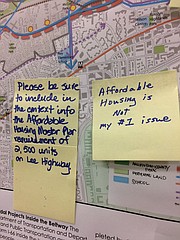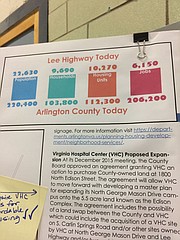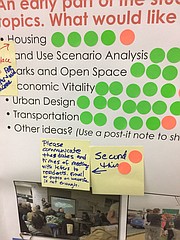Sara Rubida (left) and WIllie Jackson (right) look over the maps at Lee Highway planning meeting. Photo by Eden Brown.
“So what does economic revitalization mean? Economic vitality? There are already very many longstanding and successful businesses on Lee Highway; what are their needs what are their problems? Are underground facilities being considered? Why Lee Highway now?”
These were some of the questions asked at the Lee Highway Corridor Planning meeting held on Nov. 29. The meeting was a chance to engage with planners and local civic groups on the Lee Highway plan, which covers a five-mile long corridor owned by the VIrginia Department of Transportation (VDOT). The Lee Highway Alliance, made up of 20 associations — mostly civic — began to look at Lee Highway planning when they realized change is occurring and development pressure will increase.
The alliance started working with the county as a strategic partner. It have has submitted papers to become an official nonprofit organization, and
will have a board of directors and office space to give people a place to talk as the process goes forward.
Arlington County planning staff noted to the group of roughly 85 local citizens that night — and more than 100 during the noon session — that they needed to be aware of the possibility that residential edges (purple on the map) might be affected by the plan. In addition, the planners asked for approval for commercial and multi-family areas to have the most focus in the plan. They indicated to attendees that the end product of this process would be transportation improvements, open spaces improvements, and an overall vision of what Lee Highway would look like down the road. They told the group they would like the process to take less than five years so that planning fatigue would not become a factor.
The question and answer period indicated intense interest on the part of those residents who came to the meeting. They asked, “Is the East Falls Church Metro plan separate from this plan?” They heard: “No, it's within the planning area. We would be coordinating with them. We would not revisit those plans but would look at areas that don't already have those plans in place.”
They asked: “Have you thought about changes to I-66 which could have an effect on this plan?” They heard: “Yes, we have VDOT on our team. But we haven't started on this discussion yet. It is true that VDOT could affect the right of way constraints, and how much space we have to work with.”
They asked: “How will this affect the schools? None of us want to see the number of trailers on our school campuses increase.” County officials said “We have an APS person on our team as well.”
Other questions ranged from “What's the impact on our public facilities?” to “Your list of stakeholders doesn't seem to include people who live outside the purple boundaries; there doesn’t seem to be consideration given to those people, especially those who don't live close enough to walk to Lee Highway.” The county responded that those people are considered stakeholders too. Attendees asked whether putting some things underground was being considered. County responded that “undergrounding is a very expensive option for development but will be considered.” As for the range of height for buildings along the corridor, the county said they were nowhere near ready to say. Nowhere near ready to say. Right now it's two to four stories for commercial facilities but many apartments are higher.”
“After going through the East Falls Church process, I realized they were just letting people talk but county planners already knew what they wanted,” said Sarah Rubida. “It seems like the county wants development, but is bigger and better the Arlington Way?” Rubida said she was venturing out again to try to have input into this new plan, but “I'm cautious about this process based on what I saw in the EFC [East Falls Church] process. I will remember forever that people were pushing to take away the parking at the Metro. Where would people like my daughter park?”
East Falls Church was, for more than 60 years, part of the town (now city) of Falls Church. East Falls Church petitioned to rejoin Arlington County and made the move in 1936, according to Arlington County’s website. The development plan, which was available at the meeting on Lee Highway’s future, calls for a “transit town” of small retail businesses and restaurants, pedestrian and bicycle friendly streets, and higher rise mixed-use buildings.
The theme of East Falls Church not being what the local residents wanted came up several times during the evening meeting. Several people asked why the county drew a hard boundary on Sycamore Street.
Rubida and others said they were distrustful of the staff which seemed to place focus on things like bike lanes, and not enough on parking and drivability.
“All I can say is I hope it's the community they listen to not the planners,” said Willie Jackson, of the Lee Highway Alliance, and a longtime resident of Hall’s Hill. She seconded comments made at the meeting that “we don’t understand what they are doing with I-66 yet. We need input on that so all those people don't drive down Lee highway. “They need to keep the history of Lee Highway in mind. Those small businesses have been there for years and they are the heart and soul of the community. Take Moore’s Barber Shop, and the tattoo shop. We can’t lose those businesses, and some of them are already having trouble with higher rents. To what end is all this development?”
The alliance noted during the meeting that they had surveyed 45 businesses along Lee Highway; their planning consultants had also talked to businesses, particularly since so many businesses could not attend the charrette session last year because they were working. The county also noted the Arlington Chamber of Commerce has been involved with the planners.
Rubida said she was glad to hear the planners state they are aware that Lee Highway, aside from being a highway, is “our Main Street.” “But,” she said, “I fear it is going to be the county's vision not the community's vision; and the older population has to be taken into account. I only live a short distance from Lee Highway, but I still won’t walk there, no matter how ‘walkable’ they make it.” Others cited the fact they drive down Lee Highway every day to work or shop as a major reason they attended the meeting.
Both women decried the changes in the neighborhood that have taken place already. Rubida said in her office at Long and Foster, “we look at statistics: for every house bought that costs a million there are three that cost more than a million. That changes the prices, the people, the rents.”
Pamela Gullen had another take on the plan. Gullen lives in the community and is an activist in civic associations; she served on the Arlington Planning Commission. She stressed the need for community participation from the beginning. People shouldn’t wait until plans are made, they should be attending these meetings now. She also noted the Lee Highway Alliance started because there were buildings going up in the area, like the apartment complex near Thirsty Bernie’s at the intersection of Lee Highway and Glebe, which was a “by right” building, not a planned one. “Lee Highway residents realized anything can happen,” she said. “The sheer price of land will force development. It’s much better to have a plan than not have one.”
Gullen also shed light on why several of the Cherrydale residents who visited the meeting had no idea that there had been a Cherrydale development plan approved in 1994. They had looked in wonder at the plan displayed at the meeting which, now more than 20 years old, they had never known existed. Gullen said the Cherrydale development plan included special allowances for higher density buildings and defined character areas like the hardware store and fire house. Over $30 million was spent to improve the sidewalks in the area, put in parking, put power lines underground, and make the area more business friendly. Gullen acknowledged development has been slower than expected, but the fact that longtime residents of the area did not see any major change could also be viewed as a good thing.
An online survey for residents is at www.arlingtonva.us/leehighway and must be finished by Dec. 9. All the slides used at the meeting are also on the website. Additionally, Lee Highway planning will be on the agenda at this Long Range Planning Committee meeting. The Five-Year Comprehensive Plan Review will also be discussed. Visit https://commissions.arlingtonva.us/planning-commission/lrpc/ for more information.



